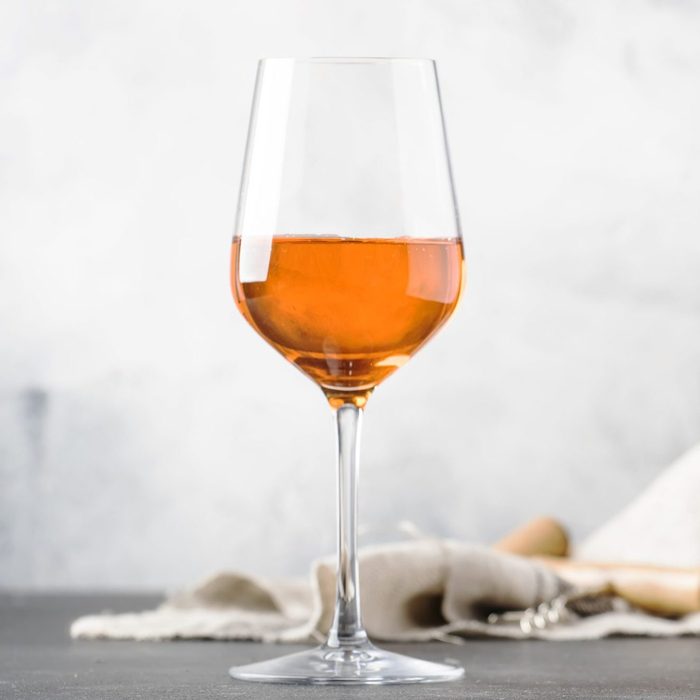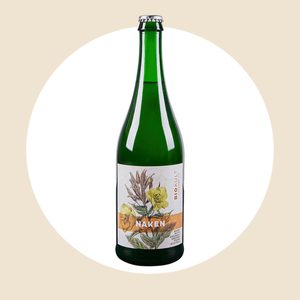What Is Orange Wine?
Updated: Feb. 07, 2024

From pairings to how it's made, discover the essentials in our expert guide to orange wine.
Once more of an under-the-radar tipple, orange wine has recently enjoyed a well-earned place in the limelight, cozying up to our favorite reds, whites, and rosés on wine lists and supermarket shelves. It’s an ancient style, but there’s nothing dated about the way orange wine tastes.
The secret behind its recent success? It’s a food-friendly wine, and like rosé, a best-of-both-worlds style you can sip on with everything from fish to poultry, and even certain meat dishes.
Ready to dive into this exciting style? Here’s everything you need to know, from how orange wine is made to how to serve and pair it with food.
What Is Orange Wine?
Orange wine is skin-contact white wine. In other words, it’s white wine made in a similar method as red wine. The name stems from the color—no oranges wind up in the bottle. All those gorgeous hues result from the pressed grape juice remaining in contact with the skins during fermentation—but more on that in a second. White grapes like pinot grigio, ribolla gialla, rkatsiteli and sauvignon blanc are the big-name varieties of the style. Something of a specialty, you’ll come across orange wine in regions like northeastern Italy’s Friuli region, Slovenia, Georgia, Australia and parts of the United States.
What Does Orange Wine Taste Like?
Some orange wine is herbaceous or tastes like juicy stone fruit. Others are bright, and packed with zesty citrus aromas and flavors. Still other orange wines boast nutty overtones, with hints of bruised Golden Delicious and honey.
Thanks to that time spent on the grape skins, orange wine is more tannic (that astringency you encounter when drinking big reds) and full-bodied compared to white wine, which flings open the doors to many more pairing possibilities. Orange wines go with everything from roast chicken to lamb. If you like cooking with spice, dishes with dashes of cumin, paprika and fenugreek make stellar pairings with orange wine. It’s a no-brainer with North African and Indian cuisine. The more herby orange wines are wickedly good with hearty vegetarian dishes like roasted artichoke, asparagus, as well as whole grains. Think along the lines of bulgur wheat or farro.
Ready to start popping corks? Treat your orange wines like a full-bodied white or quality rosé. Serve them chilled, around 50 to 57°F. The more heavy on the tannins (i.e., the more amber-hued), the warmer you’ll want to serve the wine. Skew toward colder for fresher styles. Glass-wise, reach for your white wine or Burgundy glasses.
How Is Orange Wine Made?

After pressing the grapes, the juice spends time in contact with the grape skins, seeds and stems, giving the wine color and tannins and making the wine more complex. This can last for a couple of days to a few years.
Although new to many wine lovers, orange wines have been produced for over 5,000 years. Ancient winemakers in Georgia (one of the world’s oldest wine regions) fermented their orange wines in clay vessels called qveri, which are still used today. More often, winemakers use stainless steel, oak and concrete to ferment and age their orange wines.
The Best Orange Wine to Buy First
Biokult Naken Orange Wine
Based mostly on pinot grigio, Biokult’s orange wine is a fabulous biodynamic example out of Austria. Ultra-bright, with plenty of taste bud-tingling acidity, zesty citrus, hints of honeysuckle and fragrant baking spice. It’s a killer wine to bust out with your best-loved BBQ recipes—grilled chicken, burgers or brats.
Slaveck Sivi Pinot Grigio
Hailing from Slovenia, one of the leaders in orange wine, Slaveck Sivi’s pinot grigio is packed with bright notes of lemon, red grapefruit and orange followed by layers of white peach. Bonus? It’s organic.
Vinoterra Rkatsiteli Orange Wine
From the region that first gave us orange wine all those thousands of years ago, Vinoterra makes a beautiful orange wine made from the local rkatsiteli grape. Apricot, citrus zest, cantaloupe, honey and lightly toasted nuts, pour yourself a glass with a Moroccan chickpea stew.























